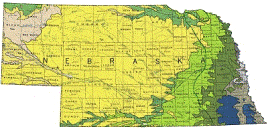United States Geological Survey

United States Geological Survey: Staff Publications
Document Type
Article
Date of this Version
1987
Abstract
The lower Eocene Willwood Formation of the Bighorn Basin, northwest Wyoming, consists of about 770 m of alluvial rocks that exhibit extensive mechanical and geochemical modifications resulting from Eocene pedogenesis. Willwood paleosols vary considerably in their relative degrees of maturity; maturity is defined as stage of development as a function of the amount of time required to form. Five arbitrary stages are proposed to distinguish these soils of different maturities in the Willwood Formation. Stage 1 soils, the least mature, are entisols; stage 2 and stage 3 soils are intermediate in maturity and are probably alfisols; and stage 4 and stage 5 soils, the most mature, are spodosols. These stages are not only time-progressive elements of an in situ maturation sequence for Willwood soil formation, but, in the lateral dimension, they are also usually distributed sequentially.


Comments
Published in JOURNAL OF SEDIMENTARY PETROLOGY, VOL. 57, NO. 4, JULY, 1987, P. 587-601.